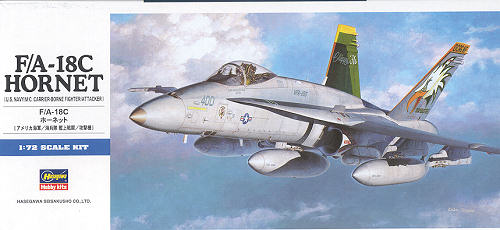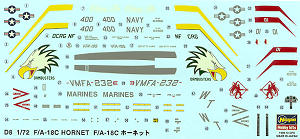
| KIT: | Hasegawa 1/72 F-18C Hornet |
| KIT #: | 00438 |
| PRICE: | $11.98 for this one. Probably higher now |
| DECALS: | Two options |
| REVIEWER: | Scott Van Aken |
| NOTES: | Basic boxing |

| HISTORY |
The F/A-18C is the result of a block upgrade in 1987 incorporating upgraded radar, avionics, and the capacity to carry new missiles such as the AIM-120 AMRAAM air-to-air missile and AGM-65 Maverick and AGM-84 Harpoon air-to-surface missiles. Other upgrades include the Martin-Baker NACES (Navy Aircrew Common Ejection Seat), and a self-protection jammer. A synthetic aperture ground mapping radar enables the pilot to locate targets in poor visibility conditions. C and D models delivered since 1989 also include an improved night attack capability, consisting of the Hughes AN/AAR-50 thermal navigation pod, the Loral AN/AAS-38 Night Hawk FLIR (forward looking infrared array) targeting pod, night vision goggles, and two full-color (previously monochrome) MFDs and a color moving map.
Beginning in 1991, Hornets were upgraded to the F404-GE-402 engine, providing a 20% increase in thrust.
In 1992, the original Hughes AN/APG-65 radar was replaced with the Hughes (now Raytheon) AN/APG-73, a faster and more capable radar. The A model Hornets upgraded to the AN/APG-73 are designated F/A-18A+. Since 1993, the Nite Hawk also has a designator/ranger laser, allowing it to self-mark targets. The aircraft is currently operating with Marine and many USN squadrons, though several are currently converting to the F-18E Super Hornet.
| THE KIT |
 Hasegawa's kit of the F-18 is by no means new. The original kit was a prototype with raised panel lines and fairly good detailing. This kit had enough differences with the production F-18 that a new one was tooled in the mid 1980s; this new kit having engraved panel lines.
Hasegawa's kit of the F-18 is by no means new. The original kit was a prototype with raised panel lines and fairly good detailing. This kit had enough differences with the production F-18 that a new one was tooled in the mid 1980s; this new kit having engraved panel lines.
The kit is really quite well done and despite its growing age, holds up well when compared to more modern kits, though the engraving could be considered by some to be a bit soft. This is apparent when comparing the base kit against the dedicated F-18C/D sprue that is included. The rather basic cockpit consists of a two piece seat, floor with side consoles and a control stick. The instruments are decals, which works well in this scale.
Hasegawa is a master of the 'multiple variants' and so all of their 1/72 F-18A/B/C/D kits have a set of four base sprues to which are added whatever is needed to make the specific variant. That means that the molds for these have gone through a lot of cycles. Despite that, they have held up well with only a bit of flash found. I also found two rather large depressions just forward of the LEREX exhaust that will have to filled in.
The dedicated F-18C sprue includes new fins, one nose gear door, and a few lumps and bumps that are part of the F-18C package. The rest is all F-18A. For things under wings you get three ferry tanks and two sidewinders. Any bombs will have to come from the various weapons sets. The two intake mounted sensors are included if you wish or you can attach Sparrows. I've rarely seen F-18s with Sparrows in this position. The boarding ladder may be posed down if you wish. Actually, there is no 'well' for it so that is a tad inaccurate. The canopy and windscreen are separate. No canopy actuator mechanism is included if you wish to pose your canopy open. I also feel that the kit has the earlier F-18A seat and not the proper one for an F-18C. You may wish to substitute an aftermarket one for that. 
Instructions are as good as you'd expect from a Hasegawa kit with Gunze paint references. Markings are provided for two aircraft. One is the box art aircraft 'Chippy-Ho' from VFA-192 in 1998. The modeler will have to paint the inner fins in green, but decals are provided for the rest. The other is a VMFA-232 aircraft of the Squadron Commander. The decals themselves are typical Japanese with the whites being a bit on the ivory side. How these will work with setting solutions is a bit of a crap shoot, so you may want to consider aftermarket. A full set of stencils is also included along with an excellent placement guide.
| CONCLUSIONS |
So, what you have is basically a mid 1980s kit with a late 1990s sprue addition (the kit is dated 1999), that does make into a very nice model. The real benefit of this kit is that if you want to do an F-18A from it, you can without any problem as all the bits are there.
September 2006
Thanks to me for providing this kit for you.
If you would like your product reviewed fairly and fairly quickly by asite that has over 300,000 visitors a month, please contactme or see other details in the